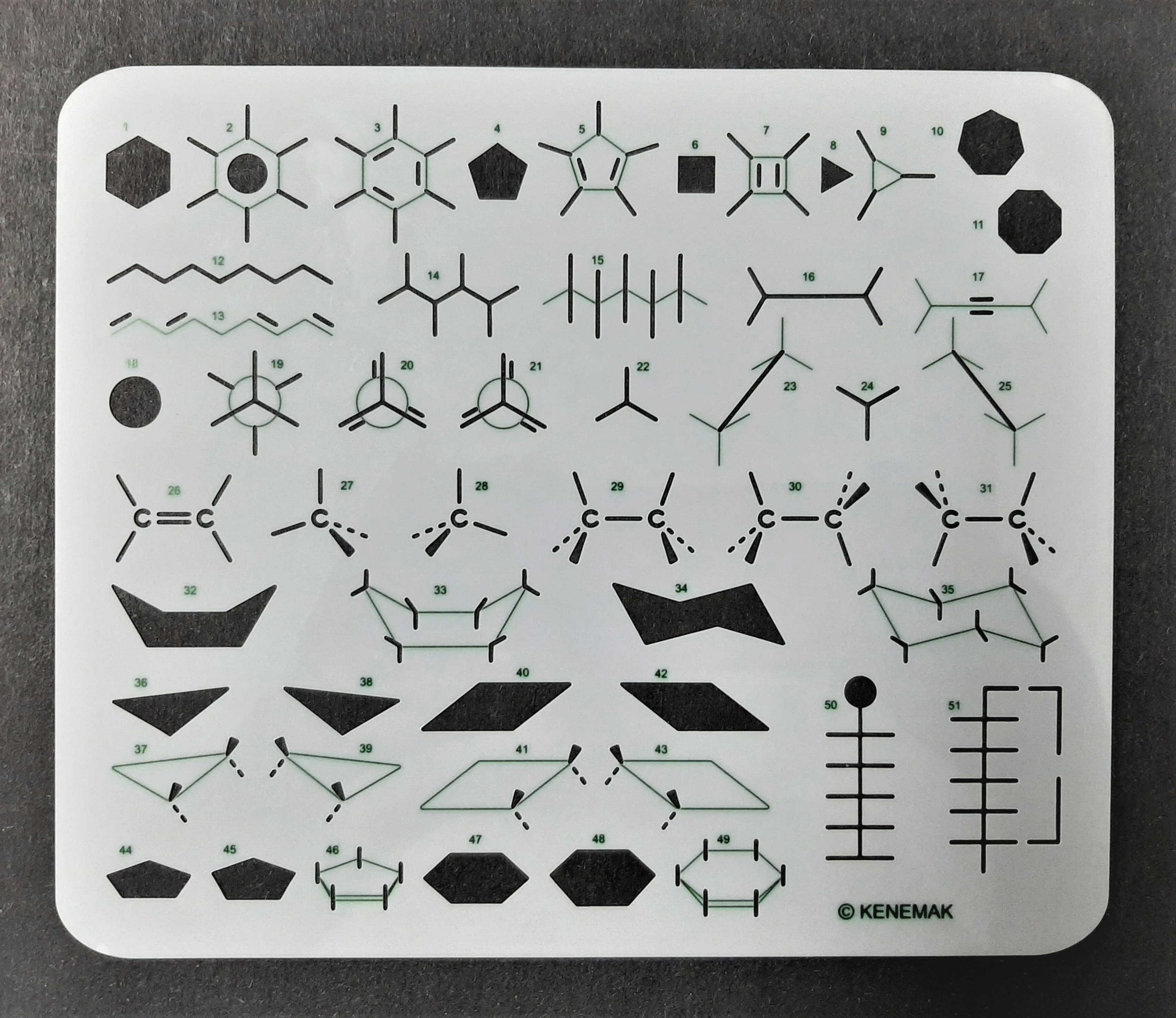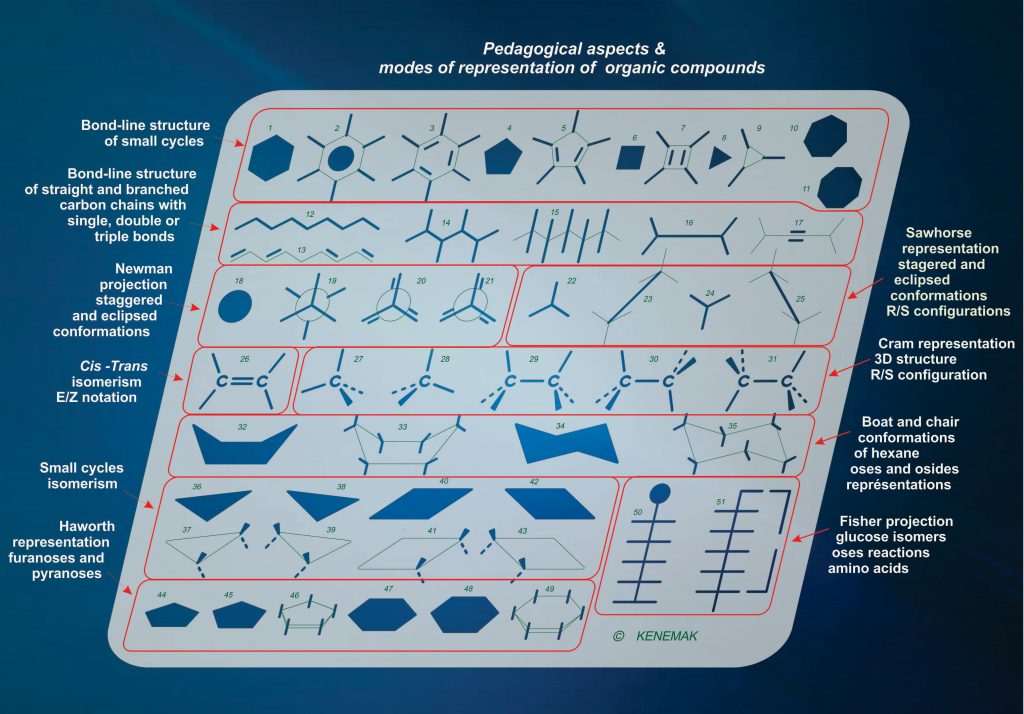Organic Chemistry Stencil
Molecular Drawing Template
Created by a passionate professor, this is the most complete stencil for drawing organic molecules.
Fast execution, neat appearance and accurate representation!


Interesting and unique aspects of this stencil
Due mainly to its flexibility, it is a very user-friendly template with a good grip, allowing fast, aesthetic and precise drawing.
All items are numbered and grouped by the type of molecular representation structure, to facilitate the professor’s work and the student learning.
Its content is relevant from your first organic chemistry course up to the university level.
This stencil is semi-transparent, thin, very flexible and resistant.
Made of recyclable Mylar, it measures 225 x 190 x 0.28 mm
This precise tool has the most elaborated content to design the types of structures of organic molecules listed below.
Educational purpose

I. Bond-Line Structures
- Benzene and aromatic compounds, cyclohexane and other small cycles
- Straight or branched carbon chains with single, double or triple bonds
- Saturated or unsaturated cyclic chains with ramifications
- Open chains containing heteroatoms
- Heterocycles and steroids
II. Three Dimensional Structures (Wedge/Dash)
- One asymmetric carbon (enantiomerism and R/S configurations)
- Two asymmetric carbons (diastereoisomerism and R/S configurations)
- Carbon chains with or without heteroatoms
III. Geometric Isomerism of Carbon-Carbon Double Bond and Small Cycles
- Cis-trans isomerism
- EZ-iso wedge/dash
IV. Newman Projections (Conformers and Optical Isomers)
- Staggered conformations
- Eclipsed conformations
- One or two asymmetric carbons
V. Sawhorse Structures (Conformers and Optical Isomers)
- Staggered conformations
- Eclipsed conformations
- One or two asymmetric carbons
VI. Conformations of Cyclohexane, Oses and Osides
- Chair Conformation (equatorial and axial bonds)
- Boat Conformation (equatorial and axial bonds)
- Oses and osides representations
VII. Fischer Projections
- One asymmetric carbon (oses, amino acids, etc.)
- Two asymmetric carbons (oses, amino acids, etc.)
- Multiple asymmetric carbon chains (oses reactions)
- Glucoses isomers
VIII. Haworth Formulas
-
Furanoses
-
Pyranoses
Examples of the molecules you can draw
WHY IS THIS DRAWING TEMPLATE USEFUL TO STUDENTS?
The stencil proves its usefulness during learning and assessment activities such as taking notes in class, doing exercises and writing lab reports and exams.
Because the students draw themselves the molecules, while respecting the conventions that apply, they contribute to their own learning process.
The stencil contributes to the improvement of a student’s understanding of organic chemistry particularly if one has difficulties in drawing spatial representation of molecules.
Given that students draw organic molecules in accordance with set conventions, they get a better perception of the spatial layout of those molecules, which lies at the very root of the study of their properties.
The use of the stencil sets a standard size for the various structures not only in notebooks and while doing exercises, but in exams as well. Students gain time in execution while their note taking and exercises improve in quality.
Overall, the stencil stimulates students’ interest in organic chemistry and increases their chances of success.
WHY IS THIS DRAWING TEMPLATE USEFUL TO TEACHERS?
When all students in a given class use the drawing template, the teacher can devote more time to teaching actual chemistry and can spend less time going over writing conventions and 3D technical drawing details.
Because the stencil is easier to use than a molecule drawing computer program, the stencil is quite useful when preparing lesson notes, exercises and exams.
When students use the stencil, it improves their understanding of organic chemistry particularly if a student has difficulties drawing or understanding spatial representation of molecules.
OBSERVED FACT…
Studies show that people retain about:
OBSERVED FACT…
Studies show that people retain about:
Studies show that people retain about:
20% of what they hear
30% of what they sea
But 70% of what they do!
Studies show that people retain about:
20% of what they hear
30% of what they see
But 70% of what they do!
20% of what they hear
30% of what they see
But 70% of what they do!
User Guide
This learning tool facilitates the drawing of the various modes of representation of organic compounds ans thus, contributes to improve the understanding of the fascinating science of organic chemistry.
•For optimal results, we recommend using a pen or a pencil of about 0.7 mm in diameter
•For secure storing and carrying, we recommend you insert your stencil in its envelope, then between the pages of a book.
The methods of representation of organic compounds vary, and the molecules are often complex. Drawing the structures is best done step by step.
Here is an example showing how to use the stencil. Subsequently, follow the same method for any other organic structure.
Step 1.To draw the molecule from the example shown here, start by using item 1 and draw the hexagon.
Step 2.Place the green guideline of item 3 over your newly drawn hexagon. Plot the two internal double bonds of the cycle and then the two external simple bonds.
Step 3. Place item 14 on the lower edge of the hexagon as shown. Draw the appropriate bonds to complete the structure.

To insert the symbol of one or more atoms in a formula, shorten the length of the bonds, as shown in the example ereafter.

You hold the key to achieve great results!
Do you have any questions?
Send us a message!
©2019 • ALL RIGHTS RESERVED • KENEMAK
The stencil is protected by copyright.
Through the years, the seller has acquired for the stencil various copyrights from relevant regulatory authorities.
Although the copyright date printed on the stencil is 2008, which marks the first year the stencil was commercialized, any entity in violation of the registered copyrights as of 2005 and beyond, whether it be a person, an organization or a business, risks being sued.
